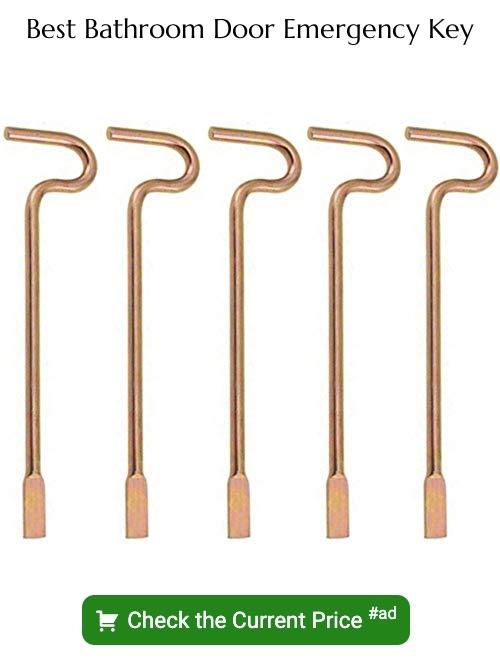Last updated on
Discover practical solutions to unlock a bathroom door that’s been inadvertently secured from the inside.
Key takeaways:
- Use a flathead screwdriver or a paperclip to turn the locking mechanism.
- Insert a thin object into the small hole on the exterior knob.
- Slide a credit card between the door and frame to push the latch back.
- Always approach the situation calmly and avoid damaging the lock.
- Call a locksmith if methods fail or for urgent situations.
Unlocking Bathroom Doors From the Outside
Confronted with a bathroom door that’s locked from the inside can be an inconvenient predicament. Fortunately, most bathroom locks are designed with built-in fail-safes which allow them to be opened from the outside.
Starting with the simplest method, you can often use a flathead screwdriver, or even a bobby pin, to turn the locking mechanism. Simply insert the tool into the door knob’s slot and turn.
Some doors feature a small hole on the exterior knob. By inserting a thin object, like a paperclip or a small screwdriver, into this hole, you can usually trigger the release mechanism.
If these methods don’t yield success, sliding a credit card between the door and the frame can sometimes push the latch back enough to open the door. This method, however, is less effective on deadbolts or higher quality locks.
It’s crucial to approach the situation calmly and consider the type of lock before applying force that could damage the door or the lock itself.
Steps to Prepare Before Attempting to Unlock
Before diving into the task, ensure privacy and safety. Inform the person inside, if possible, of your intent to unlock the door to prevent any alarm.
Gather your tools: straightened paper clips, small screwdrivers, or a thin piece of plastic are often sufficient.
If the door has a privacy push lock, locate a small hole on the doorknob. For twist locks, prepare to turn the mechanism with an appropriate tool.
Always proceed with patience to avoid damage to the lock or door.
Different Techniques to Manipulate the Lock Mechanism
Push-button locks typically surrender to the simple push of a rigid tool through the hole on the doorknob. An unfolded paperclip or a small screwdriver will usually do the trick by depressing the locking mechanism and freeing the door.
For twist locks, a coin or a flathead screwdriver can be gently turned in the slot on the outside knob until the lock disengages. This method implies that sometimes the most common household items are your best allies in a seemingly locked situation.
Now, a privacy lock with a key requires a bit more finesse. A small, thin device, such as a straightened bobby pin or a pick, can be inserted into the keyhole to jiggle the pins into place. It’s like playing a mini-puzzle, only the reward is access to your own space.
Lever-handle locks often respond well to the credit card method. Sliding a laminated card between the frame and the door where the latch is located can push the latch back into the door. This approach isn’t just a favorite of movie protagonists; it’s a handy real-world hack as well.
Remember, these methods are intended to be utilized responsibly. They are meant for situations like helping a child who accidentally locked themselves in, not for any form of illegal entry, which is unethical and, in most situations, illicit. Always respect privacy and property.
When to Call a Locksmith
A locksmith is your go-to professional for dealing with stubborn locks but knowing the right moment to call one can save time and money.
First, if you’ve tried several methods to unlock the door without success, it’s imperative to seek expertise. Prolonged tampering can damage the lock, leading to more expensive repairs.
Secondly, safety is paramount. If there’s an urgent need to access the bathroom due to a medical emergency or if a child is locked inside, it’s time to skip DIY tricks and immediately opt for professional help.
Lastly, modern lock systems, particularly those with a keyless entry or smart technology, often require specialized tools and knowledge. If your bathroom door features such a system, avoid a tech headache and let a locksmith handle the situation efficiently and damage-free.
Tips for Preventing Future Lock-ins
Regular Maintenance:
Ensuring that your bathroom door mechanisms are well-maintained is crucial. Frequently check if the lock is functioning smoothly and apply lubrication when needed to prevent the lock from getting stuck.
Choosing the Right Lock:
Invest in a quality privacy lock that can easily be unlocked from the outside in case of an emergency. Avoid high-security locks in interior bathrooms where the risk of getting locked in outweighs the benefits of a stronger lock.
Educating Household Members:
Teach everyone in your home, especially children, how to operate the bathroom lock correctly. Make them aware of what to do if they accidentally lock themselves in.
Accessibility of Tools:
Keep a small toolbox or specific unlocking tools like a flathead screwdriver or a pin in an accessible place. Knowing where these are when you need them makes responding to lock-ins faster.
Lock Replacement Policy:
As locks wear over time, institute a policy for when to replace them. This could be based on age, after a certain number of uses, or as soon as any abnormal functioning is noticed.
Avoiding Locks for Certain Users:
Consider not using locks for bathrooms that are frequently used by individuals who may be more prone to accidental lock-ins, such as young children or elderly family members, opting instead for simple latch mechanisms.
Continue reading:
Recap

